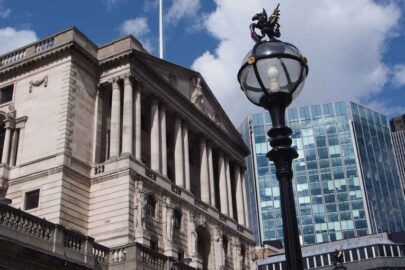The Bank of England’s Monetary Policy Committee (MPC) has voted to hold the Bank Rate at 0.1%.
The MPC voted unanimously on the Bank Rate, as it also did for the Bank of England to continue with its existing programmes of UK government bond and sterling non-financial investment-grade corporate bond purchases, financed by the issuance of central bank reserves, maintaining the target for the total stock of these purchases at £745 billion.
The central bank warned that the unemployment rate is projected to rise materially, to around 7½% by the end of the year.
12-month CPI inflation increased to 0.6% in June from 0.5% in May. CPI inflation is expected to fall further below the 2% target and average around ¼% in the latter part of the year, largely reflecting the direct and indirect effects of Covid-19.
Helal Miah, investment research analyst at The Share Centre, said: “With interest rates remaining at 0.1% what’s more important in this latest update is the assessment of the current state of the UK and global economy amid the pandemic. In this regard policy members still believe the damage to the economy is not as severe as first feared but do expect the economy in the second quarter to be 20% smaller than in the final quarter of 2019. However, more recent high frequency data suggests consumption levels have shown further improvements and the housing market appears to have returned to normal levels of activity.
“But there is evidence that business activity and investment decisions remain very weak. By year end they expect the unemployment rate to rise materially to around 7.5% and GDP will not return to pre-crisis levels until the end of 2021.
“This morning’s statement ties in with my view that we’re still in the early days of the economic fallout from this crisis. We should welcome the recovery since the trough, but far more hurt is due to come down the road as the unemployment rate nearly doubles by year end as furlough and job retention schemes come to an end by Autumn. Going forward, I fear consumption rates will be replaced by higher savings rates; meanwhile it’s fairly evident that businesses are extremely cautious and understandably so with multiple waves of the disease and more lockdowns likely down the line. Risks are skewed to the downside, if this materialises further action will be needed but policy members are eager to downplay the chance of negative interest rates saying that it will have little merit, we are more likely to see further QE stimulus instead.
“Investors face a fairly tough choice at the moment; go with safe cash equivalent products with virtually zero or negative real returns or the stock market knowing the UK and global economy is under severe strain. Those searching for income can still find decent yields, look at the pharmaceuticals and utilities, while even those that have cutback offer good long term yield prospects since investors can now buy them at a lower price such as BP and Shell.
“Meanwhile, sectors that have done well out of this crisis such as technology and healthcare still attract growth seeking capital. As we have seen over the last decade though, Central Bank policy has driven investors’ asset allocations, with an ultra-accommodative stance likely to be ongoing for some time yet and I see nowhere else where money can be placed for some real returns.”
